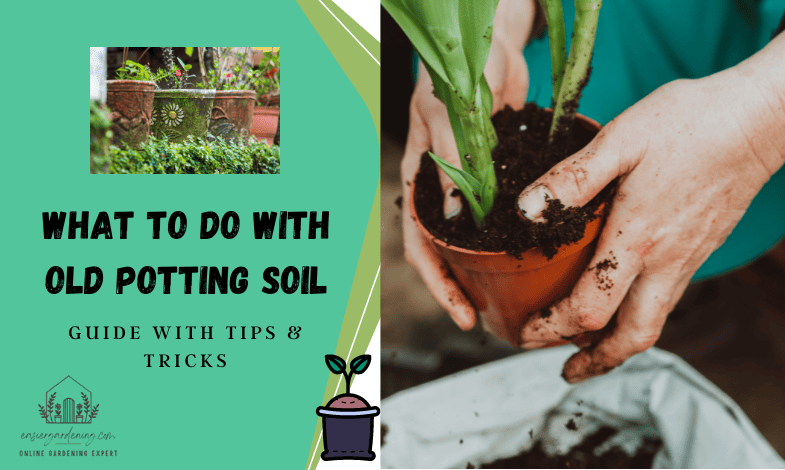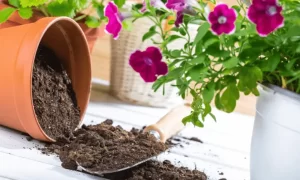What to do with old potting soil? – Best Tips to Do with Old Potting Soil: Do you throw away old potting soil? Have you ever wondered how long potting soil actually lasts and whether you should still use old potting soil? Whether in bags or a window box – with the start of the planting season, the question always arises whether old potting soil from the previous year can still be used. Under certain conditions, this is quite possible and you can indeed still use the soil. In other cases, it is better disposed of in the garden.
Why use special potting soil at all and not just take normal soil from the garden? Because the soil from the bag can and must do a lot more. They can absorb water and nutrients, hold them, release them when needed, and always stay nice and loose. Only high-quality soil can do that. Normal garden soil is completely unsuitable for this, it would soon become flabby and collapse. Today, this article is all about what to do with old potting soil.
Contents
What to do with old potting soil: Can you still use old potting soil?
How to store old potting soil? Potting soil in a still closed bag that has been stored in a cool, dry place can still be used after a year. If the bag has already been opened and stored outdoors for the entire season, the most you can still use the old potting soil for insensitive balcony plants, but it is better to use it for soil improvement or mulching in the garden. Open potting soil also dries out quickly, so mix it 1:1 with fresh soil if you want to continue using it for container plantings.
Tips: Old soil from the flower box is best disposed of in the compost.
Where to put the old soil from balcony plants?
Can you reuse old potting soil? Well, used potting soil, however, does not necessarily have to be disposed of every year. Especially if you don’t have a garden at hand, “soil recycling” is definitely a good idea. By the way, it saves you the hassle of carrying it around. Tap out the root balls in a small tub, sort out the coarser root pieces, and then overwinter the leftover soil in a pot in a rain-protected corner of the balcony. This usually leaves less soil than you’d expect once the root balls and pieces are gone. Next spring, this soil can then be mixed with fresh soil and put back into the pots and planters.
Read more about How to store potting soil?
Can potting soil go bad?
If the old soil was not too moist or even muddy, overwintering is not a problem. If the soil is too moist or peat-reduced or peat-free soil that contains a high percentage of wood and compost, the risk of mold is higher. Make sure that the water can drain away and that the soil is stored in an airy place. Otherwise, the only thing left to do in the end is to dispose of it in the garbage can.
Fertilize old soil
When you ask what to do with old potting soil, we can recommend you to fertilize old soil. If you want to reuse last year’s “old” soil in the spring, it should be mixed with fresh planting or potting soil. One-quarter “old” soil” to one-quarter new soil. And because the fresh soil is also freshly fertilized, you should also wait with additional fertilizer applications for the time being.
Tips: Approximately four weeks after potting is sufficient for most plants.
Continue to use old potting soil in bags
If potting soil has been stored in a cool, dry place and the bag is still sealed, the soil can be used almost without hesitation even after a year. It becomes more problematic if the bag has already been opened or has been stored outdoors over the summer. Since the soil’s nutrient supply is gradually released in warm, humid weather, even without plants, nutrients accumulate and the soil is then too salty for some plants. This uncontrolled release of nutrients mainly affects slow-release mineral fertilizers, whose coatings dissolve when exposed to heat and moisture, releasing the nutrients into the soil. This is fine for hardy and insensitive balcony plants such as geraniums, petunias, or marigolds, but most houseplants and fresh seedlings are overwhelmed by it.
However, it is completely unproblematic to use old potting soil in the garden as planting soil, mulch, or for soil improvement. It doesn’t matter if the bag was already open or not. Just spread the soil on the beds, under shrubs, or even between perennials or vegetable rows.
Another weak point is the water content of the potting soil. Because if you’ve already taken some out, the rest in the bag can dry out, or at any rate become so dry that the soil is very reluctant to absorb new water. A problem with flower boxes. If, on the other hand, this potting soil is used as a planting soil or for soil improvement, this is not a problem. Most garden soil already ensures that the soil gradually becomes moist again and you mix the potting soil with the garden soil anyway. If the dry soil is used for containers, it is mixed 1:1 with fresh soil. Waste management office. In Nuremberg, too, the recycling centers do not accept old soil; larger quantities must be disposed of at a charge via specialist companies.
What to do with old soil from the flower box?
The situation is different for old soil from pots and flower boxes. As a rule, it is only suitable as a soil conditioner or for compost. The risk of overwintering fungi or pests is too great, and after one season in use, the potting soil is no longer structurally stable. It would collapse and become waterlogged during continuous rainfall – the certain end for most plants.
Learn more about How to get rid of soil mites?
Final Thoughts: What to do with old potting soil?
If you ask what to do with old potting soil, there is only one exception, namely in the balcony garden. If you have used high-quality branded soil there, and the plants were certainly healthy, you can use the soil again for summer flowers and save yourself some lugging around: One peppers the not rooted part of the old potting soil with horn chips and mixes it 1:1 with fresh substrate.
Often, at the end of the season, the old potting soil in boxes and tubs consists only of dense root tangles. A second career as a mulch or soil conditioner is thus ruled out, and the potting soil goes to the compost. To prevent microorganisms from choking on it, the root system should first be broken up into manageable pieces with a spade or garden knife.



